Poems published as ISLAND REVERIE
Text by John Stewart
Photography by Ferdi Businger
2010
Sinclair is one of the 200+ islands that make up the San Juan Islands north of Puget Sound, about 85 miles from Seattle. Our cabin there is our very special place. The island consists of about 1500 acres and 111 “places” from city lot-size to 100 acres. There are only a handful of year-round residents, especially because, in the winter, it’s gray, damp, windy, and inhospitable. Between May and September, though, it’s glorious—smooth or white-capped salt water, forested hills and snow-capped mountains in the distance, serene quiet, and no pavement. It’s off-the-grid living at its best.
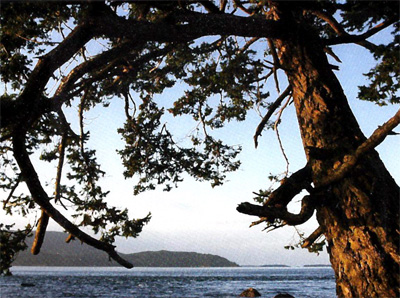
In 2009 and 2010, I was inspired to write some verses describing several of Sinclair’s wonders, and my friend Ferdi Businger, a photographer who lives there year-round, supplied images to illustrate the words. We self-published the result in a little book we gave to friends at Christmas.
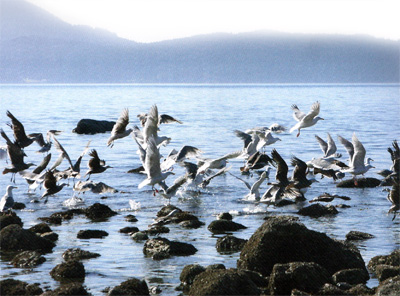
GULL
Ubiquitous and social,
Numerous as avian insects,
Shrill cacophony atop a herring ball,
Shameless forager,
Acrobatic flight for food,
Raucous at rest or in motion,
Subtle as a tsunami.
Gulls gleam in white and shades of gray.
Seldom single,
They cluster, scold, complain, and warn.
Aloft, they soar and glide,
Or wheel, turn, flit, peck, screech.
A union organizer’s nightmare,
Herdsman’s downfall,
Manager’s waterloo,
Sergeant’s raw recruits.
But little else says Life so strongly,
So reminds us of the world’s excess energy,
Surrounding.

BUTTERFLY PUZZLE
Which human ancestor
First earned the right
To enjoy a butterfly?
Whom do we thank?
No reason explains this beauty,
No function demands these wings,
No camouflage this color riot,
No survival this joyful flit.
Some say the vivid panes evolved by chance,
Their beauty “luck of the draw.”
Others explain the color riot as mime of favorite bloom.
But could this splendor come from trick or copy?
Butterflies don’t make sense,
Reward good, repay loyalty, acknowledge obedience.
Like hummingbirds, they
Confirm grace,
Lavish the exquisite,
Prompt joy,
Evoke gratitude.
And reassure, in the worst of times,
That God loves us.

BLACKBERRY
Tangled, painful, thorny canes intrude,
Obscure, divert, obstruct,
Assert control over tax-supported acres.
Ignoring human plans and uses,
Mindless of boundaries,
Proliferating willy-nilly,
With aggression.
Then late summer’s fruit earns sweet forgiveness
For all the past year’s trouble.
A wait past black to plump
Provides a symphony
Of rich, fresh, dark red wine honey,
Delighting tongue top, tip, and edges.
Unparalleled for jelly,
Seedy scrumptious for pie,
Deep sweet for cobbler.
Or finger-stained fresh snack,
Fulfills the promise of a warm and lazy August afternoon.
There’s no neutrality here:
Sharp-thorned canes block, scratch, cut, puncture,
Obstreperously interfere.
And
Luscious, rich-hued, syrupy fruit
Serenades the tongue
A symphony of opposites.
Hurtful and joy-making.
Just like us.
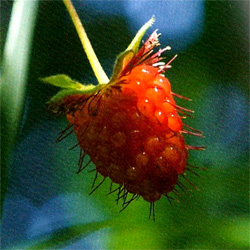
SUBTLE SALMONBERRY
One or two wink carrot-red
‘Round trident leaves.
Never excess clumps
Like brash blackberry kin.
Sphere-heart of plump juice buds
Capped with tiny, cropped red
And lime-green fronds.
The glisten promises raspberry pow,
Blackberry wine,
Or strawberry intensity.
But this one whispers to my tongue.
Slow succulence,
Gentle taste bud tickle,
Soft-sweet smoky tart,
No shouting in the forest.
Alert critters notice
And enjoy.
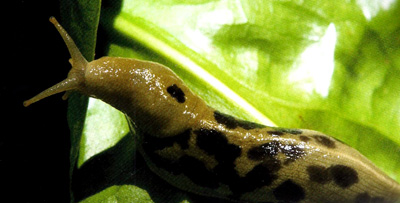
WOULD A ROSE BY ANY OTHER NAME. . . ?
Minding its own business,
Glacial-paced,
Trailing iridescence,
Antennae probe the air.
A gourmet meal for ducks and geese.
Would such a one be honored
If it weren’t named “slug”?
Saying half-gags,
Echoes heavy, primal, base.
Sounds like “ugh.”
Truth is, it’s nude escargot.
Usually polite,
Threatens only leaves and fresh-cleaned decks.
God’s counter-hectic prompt,
Model of heart health.
Can we let it teach us?
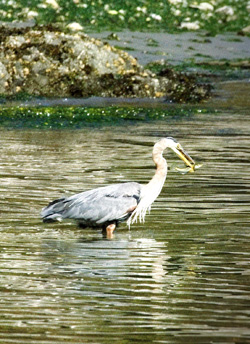
ARDEA HERODIAS
(Great Blue Heron)
Robust, streamlined shape,
Fragile legs,
Clown-sized feet,
Assertive beak,
Slender, rhythmic neck,
Wide wings,
And powerful, grace-filled flight.
Not quite “great.”
Much more gray than “blue.”
Yet this heron holds its own
On the beach.
Subservient to eagle,
Patient with persistent gulls,
Lording over loons,
Aloof from sandpiper scurries,
Distinguished most by rare and raucous cry,
“Graawwwwk!”
That sound startles,
But the takeoff, climb, and easy glide
Say “All is well.”
“She breathes.”
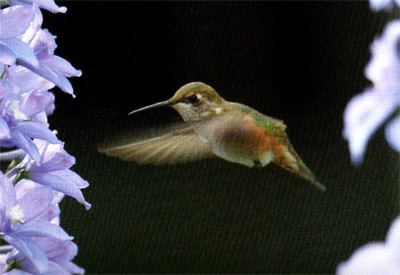
HUMMERS
Thrum, flit, hover, attack,
Wheel, dart, streak, pursue,
And incessantly imbibe
The syrup humans mix and offer.
Any red’s attractive,
Real or ersatz flower throat’s a target.
Sweet’s location speedily shared,
Pecking order aggressively enforced.
How can wings beat so fast?
Flying bodies turn so sharp?
Teacups migrate so far?
Entire lives be spent at such intensity?
Hummers exist as God’s reminders
Of how not to live.
Sure, food’s important,
Friends, too,
And moving ‘round.
But if your life resembles theirs
In almost any way,
It’s time to stop.
Change.
Disengage.
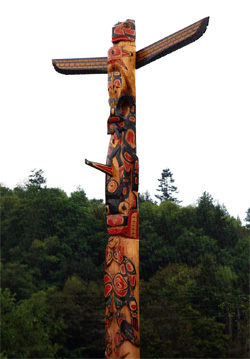
WESTERN RED CEDAR
Beam, robe, shake, canoe,
Flag pole, sacred box, arrow shaft, floor,
Landmark, rain hat, halibut hook, cook plank—
How many trees serve this multitude
Of tasks, roles, generations, and cultures?
Western red cedar’s the patriarch of this forest,
The lord of this damp domain.
Left to mature, cedar surpasses hearty douglas fir,
Stretches over coned and conical hemlock,
Dwarfs its deciduous serfs in height and girth.
Identification’s easy—
Striated bark inviting peels,
Flat-sided, lacy, deep green boughs.
Heartwood straight-grained and fragrant:
Fresh, verdant, deep forest olfactory delight,
And bane to moths.
Worried about what’s next for you?
Questioning your options?
Weighing paths?
Caught up in concrete, musts, and clocks?
Find a cedar older than you,
Clear a place nearby, light at your back.
Sit comfortably.
Breathe.
Be silent.
Accept.

EAGLE
First light strikes the beach like the golden beam
of a flashlight shined under the bed,
Painting rocks deceptively warm and
Casting highway-letter shadows.
Eagle family’s already up, of course.
Dad, imperiously observing from topmost spire,
Mom faking disinterest,
Brown youth exercising hunting skills.
A creature with seven-foot wings
Cannot do anything subtle or mundane.
Each epitomizes “rule the roost.”
Sight a match for Google earth,
Coloring majestic and stark,
Murderous talons, laser-aimed.
Existence on its own terms,
Strictly My Way.
Every food chain starts somewhere,
With hunter that’s never hunted—
Except by homo sapiens.
What’s a country saying when
Eagle is its symbol?
One beauty of the island is that
Such questions can be shelved.
Just notice eagle’s grace,
Awe-inspiring strength,
Calm independence,
Life in harmony with earth’s breathing.
What can we learn?

YOU THINK IT’S LOWLY?
Small, widely-spaced in most tide pools,
Flat colored gray,
Life hidden underneath.
No sound, motion, complaint.
Looks first like its name sounds:
Whelk.
But closer scan links whelk with
Cosmic mystery, prize, and gift with many names:
Sacred geometry, phi spiral, Golden Mean,
And from Leonardo Pisano, filius of Bonaccio,
Fibonacci, the cosmic curve
Of coneflower petals, sunflower seeds, conchs,
And drab, dull, languid whelks.
A deft incision verifies
That each spiral turn grows 6.8,
A pattern found on land and sea.
How’s this mindless blob of tissue
Know to manufacture such a chamber?
How do its cousins learn?
And what’s the link from whelk to flower seeds?
Fibonacci knew.
He learned from monks and priests.
Which of us, when seeing such exquisite shape
In such mundane a creature
Can say we’re alone?


